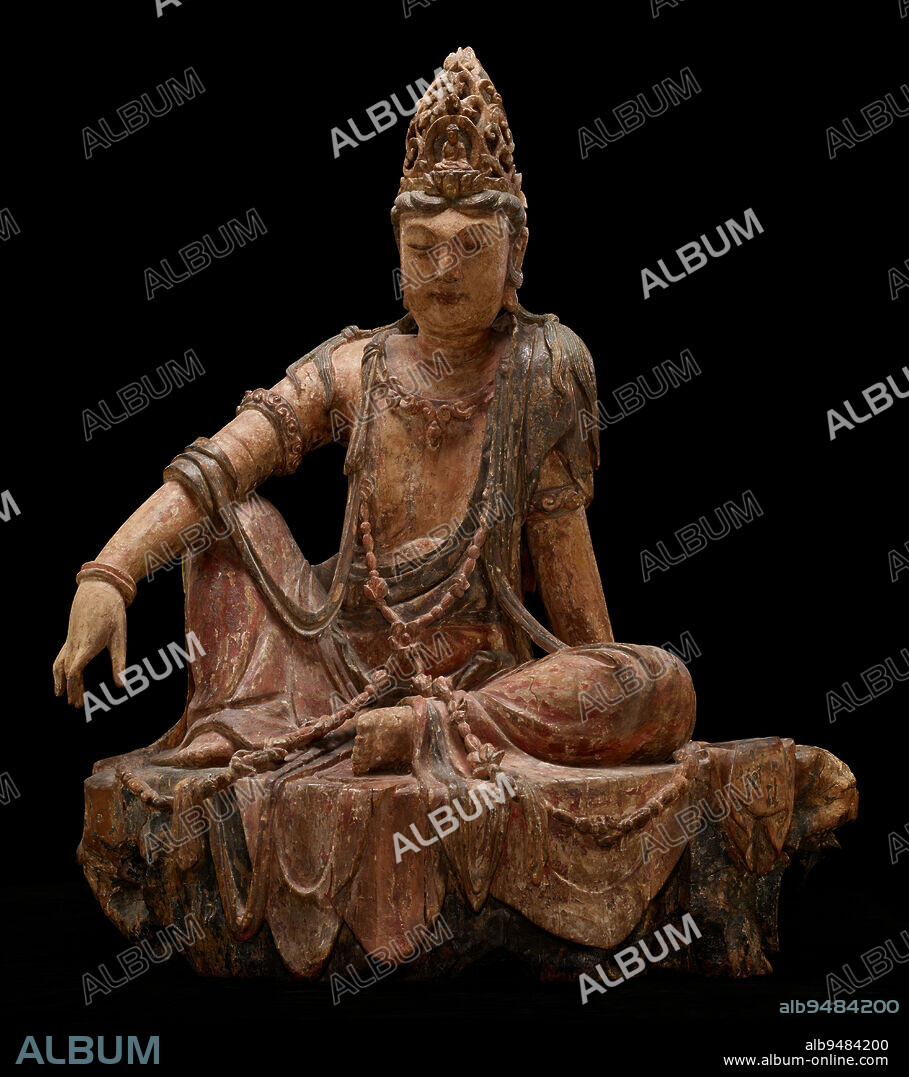alb9484200
Avalokiteshvara Bodhisattva in the Water-Moon Form (Shuiyue Guanyin), 12th century, 40 1/2 x 33 1/2 x 20in. (102.9 x 85.1 x 50.8cm), Wood, gesso and pigments, China, 12th century, Of the many manifestations of the bodhisattva Avalokiteshvara, perhaps none was more prevalent in East Asia than the uniquely Chinese form known as 'Water-Moon Avalokiteshvara,' which later also spread to Korea and Japan. This form of the bodhisattva presides over his own paradise, Potolaka, which is described in scripture as a rugged seaside cave from which Avalokiteshvara could admire the reflection of the moon in the water. Appropriately, he appears meditative and relaxed and is seated informally in the 'royal-ease' posture. Ornately dressed, with silk robes, fluttering sashes, jewelry, and an elaborate hairstyle, he also wears a headpiece that features an image of Amitbha, the buddha to whom Avalokiteshvara attends. Believers might look to a sculpture like this as a guide for their own journeys toward enlightenment.

|
Ajouter à une autre Lightbox |
|
Ajouter à une autre Lightbox |



Avez-vous déjà un compte? S'identifier
Vous n'avez pas de compte ? S'inscrire
Acheter cette image.
Sélectionnez l'usage:

Légende:
Voir la traduction automatique
Avalokiteshvara Bodhisattva in the Water-Moon Form (Shuiyue Guanyin), 12th century, 40 1/2 x 33 1/2 x 20in. (102.9 x 85.1 x 50.8cm), Wood, gesso and pigments, China, 12th century, Of the many manifestations of the bodhisattva Avalokiteshvara, perhaps none was more prevalent in East Asia than the uniquely Chinese form known as 'Water-Moon Avalokiteshvara,' which later also spread to Korea and Japan. This form of the bodhisattva presides over his own paradise, Potolaka, which is described in scripture as a rugged seaside cave from which Avalokiteshvara could admire the reflection of the moon in the water. Appropriately, he appears meditative and relaxed and is seated informally in the 'royal-ease' posture. Ornately dressed, with silk robes, fluttering sashes, jewelry, and an elaborate hairstyle, he also wears a headpiece that features an image of Amitbha, the buddha to whom Avalokiteshvara attends. Believers might look to a sculpture like this as a guide for their own journeys toward enlightenment.
Crédit:
Album / quintlox
Autorisations:
Modèle: Non - Propriété: Non
Questions sur les droits?
Questions sur les droits?
Taille de l'image:
5102 x 5749 px | 83.9 MB
Taille d'impression:
43.2 x 48.7 cm | 17.0 x 19.2 in (300 dpi)
Mots clés:
12E SIECLE • 12EME S • BIJOU DE TETE • BONNET • CASQUETTE • CHAPEAU • CHAPEAUX, COIFFES • CHAPEUA • CHINE • COIFFES CHAPEAUX • COIFFURE CHAPEAU • CONTEMPLATIF • COREE • COUVRE-CHEF • DOUZIÈME SIÈCLE • EAU • FORMULAIRE • LUNE • QUATRE ELEMENTS: EAU • SCULPTURE • SCULPTURES • TECHNIQUE: SCULPTURE • TRANQUILLE • VETEMENT: CHAPEAU • XIIE SIECLE
 Pinterest
Pinterest Twitter
Twitter Facebook
Facebook Copier le lien
Copier le lien Email
Email
